Distribution Records
PDF
Vetting Levels |
|
Adult phenology:
High Mountains (HM) ≥ 4,000 ft.
Low Mountains (LM) < 4,000 ft.
Piedmont (Pd)
Coastal Plain (CP)
Click on graph to enlarge
|
 |
|
| synonym | |
| taxonomic_comments |
The first mention of rufipes, a red-legged purseweb spider as from the US, was by Latreille (1829), written in French, and crediting one "M. Milbert" for its discovery. A few years later, Lucas (1834) repeated this record almost verbatim, but subsequently described and illustrated the same species under the name bicolor. He mentioned Latreille's rufipes in a footnote and indicated that he did not know whether his species was the same as that of Latreille.
There can be little doubt that Walckenaer (1837) actually had before him Latreille's specimen from somewhere near Philadelphia when he described the species again as Sphodros milberti.
In retrospect, it seems almost certain that the names rufipes, bicolor, and milberti were all based on the same specimen, a male sent as a gift to the Paris Museum by M. Milbert sometime before 1829 (emphasis added).
Paraphrased from Gertsch and Platnick (1980). |
| species_comment |
Most specimens seen are males, as they wander in May and June in search of females in the latters' silk tubes. The males have strikingly orange-red legs, as do no other Sphodros species to have been found in NC. The females, which do not generally leave their silk tubes, have no such color on their decidedly shorter legs, and tend to be more of a dark brown than the black seen on the males. |
| id_comments |
The above-ground portions of the tube are vertical and attached at the upper end, often to tree trunks; smaller hardwood trees appear to be preferred but pines and grass are used in at least some areas. The tubes are nearly uniform in width with the upper end flattened and attached to the tree by numerous, flaring strands (Coyle and Shear, 1981). They are sometimes attached to rocks, and one female specimen represented had attached her tube to a brick house foundation. (dbz, personal observation) |
| total_length |
Females 20.5-25mm, male 14.5mm |
| structural_features |
The males' red legs are distinctive. There are other males that show red on the legs, but the red coloration is not entire (and, at this writing, none of those other species has been found in NC). |
| silk_web |
A usually vertical, silken tube, wherin the female spiders dwell. |
| fld_guide_descriptions |
The female is usually overall dark brown; the male has a very dark brown to black opisthosoma and prosoma, but the legs are bright orange red. Sphodros fitchi and Sphodros atlanticus also have red legs, but note that in S. rufipes the entire femur and distal segments of the legs are red. The purseweb is usually built vertically up the trunk of a small tree. The web is often adorned with debris, helping to camouflage it. The species is often found in forested areas with sandy loam soils. (Rose, 2022) |
| online_photos |
|
| prey |
|
| predators |
|
| behavior |
The females live inside a finger-diameter silken tube that is mostly above ground, but which may extend 10cm or so below ground. When an insect (or, one might presume, another spider) walks or alights on the tube, the spider plunges her fangs through the silk from the inside to kill her prey. Once it is immobile,the spider cuts open the tube and pulls the victim inside to be eaten. |
| distribution_reference |
|
| technical_reference |
Gertsch, W. J. & Platnick, N. I. (1980). A revision of the American spiders of the family Atypidae (Araneae, Mygalomorphae). American Museum Novitates 2704: 1-39
|
| adult_id | 1 identifiable by photo 2 identifiable by photo of specific features and/or supplementary info 3 identifiable from specimen only |
| abundance |
These spiders are not often seen and usually considered to be rare, though one must wonder how any there are that noöne ever notices! |
| distribution_comments |
Eastern US to Texas and Florida. More common in southern states. |
checklist_mt_high
>=4,000 ft. | |
checklist_mt_low
<4,000 ft. | |
checklist_pd
Piedmont | |
checklist_cp
Coastal Plain | |
| habitat |
Often found in wooded areas with sandy loam soil. |
| observation_methods |
|
| state_protection |
|
| NHP_ranks |
|
| NHP_status |
|
| status_comments |
|
Photo Gallery for Sphodros rufipes redlegged purseweb spider |
 | Recorded by: Julie Leonow
Moore Co.
Comment: Male marching with a purpose across a natural pine straw path in the pine forest of the dog park. |  | Recorded by: Julie Leonow
Moore Co.
Comment: Male marching with a purpose across a natural pine straw path in the pine forest of the dog park. |
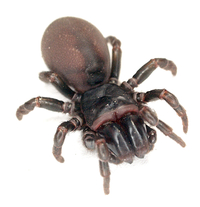 | Recorded by: Donald Zepp
Johnston Co.
Comment: Adult female, dug from damaged silken tube on building foundation. Photoed and released in same location. |  | Recorded by: Donald Zepp
Johnston Co.
Comment: Adult female, dug from damaged silken tube on building foundation. Photoed and released in same location. |
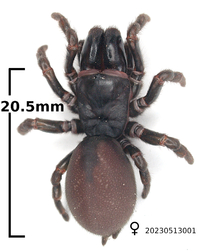 | Recorded by: Donald Zepp
Johnston Co.
Comment: Adult female, dug from damaged silken tube on building foundation. Photoed and released in same location. | 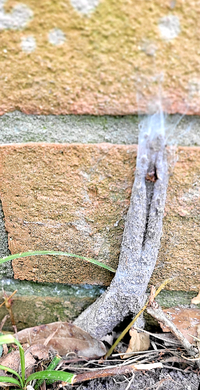 | Recorded by: Donald Zepp
Johnston Co.
Comment: Adult female, dug from damaged silken tube on building foundation. Photoed and released in same location. |
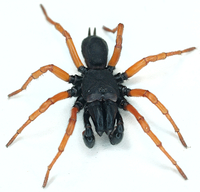 | Recorded by: Peter HULTH
Johnston Co.
Comment: Male wandering in garden. Released after ex situ photos. | 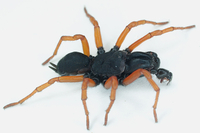 | Recorded by: Peter HULTH
Johnston Co.
Comment: Male wandering in garden. Released after ex situ photos. |
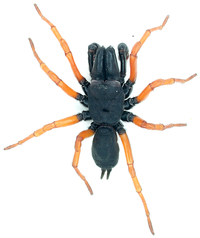 | Recorded by: Peter HULTH
Johnston Co.
Comment: Male wandering in garden. Released after ex situ photos. | 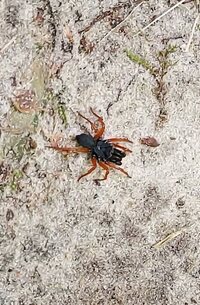 | Recorded by: A. McGovern
Camden Co.
Comment: DISW - Male, seen by visitors. @ -76.359993, 36.512579 |
 | Recorded by: C. Taunton
Wake Co.
Comment: NCMA | 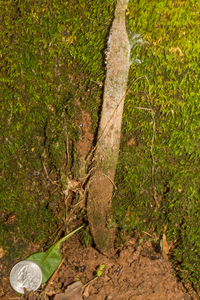 | Recorded by: Steve Hall and Harry LeGrand
Northampton Co.
Comment: Identification based on size and shape of the tube |
 | Recorded by: Carla Edwards
New Hanover Co.
Comment: CABE - Several seen in campground behind sites 40, 42, 45, 46. | 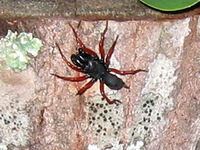 | Recorded by: Jane Wyche
Gates Co.
Comment: MEMI - First one seen crossing picnic area road. This one photographed. |
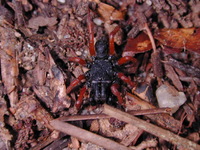 | Recorded by: Scott Hartley
Moore Co.
Comment: WEWO |  | Recorded by: Steve Hall
Durham Co.
Comment: Adult male found traveling |
|